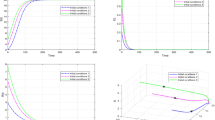Abstract
In this paper, dynamics of a stage-structured epidemic model with delays and nonlinear incidence rate is analyzed. Local stability and existence of Hopf bifurcation is discussed by choosing possible combination of the delays as the bifurcation parameter. It is proved that the unique endemic equilibrium is locally asymptotically stable when the delay is suitably small and a bifurcating periodic solution will be caused once the delay passes through the corresponding critical value of the delay. We make use of the normal form theory and center manifold theorem to obtain the explicit formulas for determining the properties of the Hopf bifurcation. Numerical simulations supporting our obtained findings are carried out in the end.




Similar content being viewed by others
References
Anderson RM, May RM (1991) Infectious diseases of humans. Oxford University Press, London
Bianca C, Ferrara M, Gurrini L (2013) The time delays’ effects on the qualitative behavior of an economic growth model. Abstr Appl Anal 2013(Article ID 901014):10
Cai LM, Li XZ, Ghosh MN (2009) Global stability of a stage-structured epidemic model with a nonlinear incidence. Appl Math Comput 214:73–82
Chen FF, Hong L (2014) Stability and Hopf bifurcation analysis of a delayed SIRS epidemic model with nonlinear saturation incidence. J Dyn Control 12:79–85 (In Chinease)
Cui GH, Yan XP (2011) Stability and bifurcation analysis on a three-species food chain system with two delays. Commun Nonlinear Sci Numer Simul 16:3704–3720
Deng LW, Wang XD, Peng M (2014) Hopf bifurcation analysis for a ratio-dependent predator-prey system with two delays and stage structure for the predator. Appl Math Comput 213:214–230
Enatsu Y, Messina E, Muroya Y, Nakata Y, Russo E, Vecchio A (2012) Stability analysis of delayed SIR epidemic models with a class of nonlinear incidence rates. Appl Math Comput 218:5327–5336
Feng L, Liao X, Li H, Han Q (2012) Hopf bifurcation analysis of a delayed viral infection model in computer networks. Math Comput Model 56:167–179
Glasser J, Feng Z, Moylan A, Valle SY, Castillo-Chavez C (2012) Mixing in age-structured population models of infectious diseases. Math Biosci 235:1–7
Gori L, Guerrini L, Sodini M (2015) Hopf bifurcation and stability crossing curves in a cobweb model with heterogeneous producers and time delays. Nonlinear Anal Hybrid Syst 18:117–133
Gori L, Guerrini L, Sodini M (2014) Hopf bifurcation in a Cobweb model with discrete time delays. Discret Dyn Nat Soc 2014(Article ID 137090):8
Hassard BD, Kazarinoff ND, Wan YH (1981) Theory and applications of Hopf Bifurcation. Cambridge University Press, Cambridge
Kermark M, Mckendrick A (1927) Contributions to the mathematical theory of epidemics, Part I. Proc R Soc A 115:700–721
Liu ZJ (2013) Dynamics of positive solutions to SIR and SEIR epidemic models with saturated incidence rates. Nonlinear Anal Real World Appl 14:1286–1299
Li X, Wang W (2005) A discrete epidemic model with stage structure. Chaos Solitions and Fractals 26:947–958
Rhodes GA, House T (2013) The rate of convergence to early asymptotic behaviour in age-structured epidemic models. Theor Popul Biol 85:58–62
Xu CJ, Zhang QM (2014) Qualitative analysis for Lotka-Volterra model with time delays. WSEAS Trans Math 13:603–614
Zhang JH, Jia JW, Song XY (2014) Analysis of an SEIR epidemic model with saturated incidence and saturated treat function. SciWorldJ 2014(Article ID 910421):11
Zhang ZZ, Yang HZ (2015) Dynamical analysis of a viral infection model with delays in computer networks. Math Prob Eng 2015(280856):15
Zhang TL, Liu JL, Teng ZD (2010) Stability of Hopf bifurcation of a delayed SIRS epidemic model with stage structure. Nonlinear Anal Real World Appl 11:293–306
Zhang ZZ, Yang HZ, Fu M (2014) Hopf bifurcation in a predator-prey system with Holling type III functional response and time delays. J Appl Math Comput 44:337–356
Zhang TL, Kang RN, Wang K (2015) Global dynamics of an SEIR epidemic model with discontinuous treatment. Adv Differ Equ 1:1–16
Author information
Authors and Affiliations
Corresponding author
Additional information
Communicated by Maria do Rosário de Pinho.
This work was supported by Natural Science Foundation of the Higher Education Institutions of Anhui Province (KJ2015A144) and Anhui Provincial Natural Science Foundation (1508085QA13, 1708085MA17).
Rights and permissions
About this article
Cite this article
Liu, J., Wang, K. Dynamics of an epidemic model with delays and stage structure. Comp. Appl. Math. 37, 2294–2308 (2018). https://doi.org/10.1007/s40314-017-0452-y
Received:
Revised:
Accepted:
Published:
Issue Date:
DOI: https://doi.org/10.1007/s40314-017-0452-y




